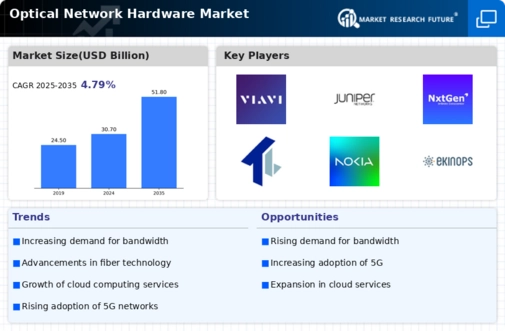Increasing Data Traffic
The Optical Network Hardware Market is experiencing a surge in demand due to the exponential growth of data traffic. With the proliferation of high-definition video streaming, online gaming, and cloud-based applications, the need for robust optical networks has intensified. According to recent statistics, data traffic is projected to increase by over 30% annually, necessitating the deployment of advanced optical network hardware. This trend is compelling service providers to invest in high-capacity optical solutions to meet consumer expectations for speed and reliability. As a result, the Optical Network Hardware Market is likely to witness substantial growth, driven by the need to accommodate this escalating data demand.
Rising Focus on Network Security
In an era where cyber threats are increasingly sophisticated, the Optical Network Hardware Market is witnessing a heightened emphasis on network security. Optical networks are inherently more secure than traditional copper networks, as they are less susceptible to eavesdropping and interference. This characteristic is driving organizations to adopt optical solutions to safeguard sensitive data. Additionally, advancements in encryption technologies for optical networks are further enhancing security measures. As businesses prioritize data protection, the demand for secure optical network hardware is expected to rise, thereby propelling growth within the Optical Network Hardware Market.
Growing Adoption of 5G Technology
The rollout of 5G technology is a major catalyst for the Optical Network Hardware Market. As telecommunications companies expand their 5G networks, there is a heightened demand for optical infrastructure to support the increased data rates and lower latency associated with this technology. The integration of optical networks is essential for backhauling data from 5G base stations to core networks. Industry analysts estimate that the investment in optical network hardware for 5G deployment could reach billions of dollars in the coming years. This trend indicates a robust growth trajectory for the Optical Network Hardware Market, as it aligns with the global shift towards next-generation mobile connectivity.
Advancements in Optical Technology
Technological innovations are playing a pivotal role in shaping the Optical Network Hardware Market. The development of new optical components, such as wavelength division multiplexing (WDM) and optical amplifiers, has enhanced the capacity and efficiency of optical networks. These advancements enable the transmission of multiple data streams over a single optical fiber, significantly increasing bandwidth. Furthermore, the introduction of photonic integrated circuits is expected to revolutionize the market by reducing costs and improving performance. As these technologies continue to evolve, they are likely to drive the Optical Network Hardware Market forward, fostering greater adoption of optical solutions across various sectors.
Regulatory Support for Broadband Expansion
Government initiatives aimed at expanding broadband access are significantly influencing the Optical Network Hardware Market. Various regulatory bodies are implementing policies to promote the deployment of high-speed internet infrastructure, particularly in underserved areas. These initiatives often include funding and incentives for telecommunications companies to invest in optical network solutions. As a result, the market is likely to benefit from increased investments in optical hardware to meet regulatory requirements. This supportive environment is expected to drive the Optical Network Hardware Market, facilitating broader access to high-speed connectivity and fostering economic growth.


















Leave a Comment